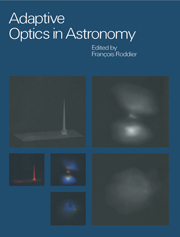Book contents
- Frontmatter
- Contents
- List of contributors
- Part one Introductory background
- Part two The design of an adaptive optics system
- Part three Adaptive optics with natural guide stars
- 8 The COME-ON/ADONIS systems
- 9 The UH–CFHT systems
- 10 Adaptive optics in solar astronomy
- Part four Adaptive optics with laser beacons
- Part five The impact of adaptive optics in astronomy
- Glossary of acronyms
- Index
9 - The UH–CFHT systems
from Part three - Adaptive optics with natural guide stars
Published online by Cambridge University Press: 23 November 2009
- Frontmatter
- Contents
- List of contributors
- Part one Introductory background
- Part two The design of an adaptive optics system
- Part three Adaptive optics with natural guide stars
- 8 The COME-ON/ADONIS systems
- 9 The UH–CFHT systems
- 10 Adaptive optics in solar astronomy
- Part four Adaptive optics with laser beacons
- Part five The impact of adaptive optics in astronomy
- Glossary of acronyms
- Index
Summary
The birth of a new concept
The astronomical AO system developed at the University of Hawaii (UH) and its offspring, the AO user instrument of the Canada–France–Hawaii telescope (CFHT) are members of a new breed of AO systems based on the concept of wave-front curvature sensing and compensation (Roddier 1988). The concept emerged in the late 1980s at the Advanced Development Program (ADP) division of the US National Optical Astronomical Observatories (NOAO), as an output of a research program led by J. Beckers on the application of adaptive optics to astronomy.
Given the success of AO in defense applications, particularly surveillance systems, it was natural to seek components developed by the defense industry. The main difficulty was to obtain a good deformable mirror at a reasonable price. The technology being classified, one had no access to the latest developments. Commercially available mirrors were either monolithic mirrors, or first generation piezostack mirrors (see Chapter 4). Whereas monolithic mirrors of good optical quality could be purchased, their stroke was insufficient for the envisioned use on large astronomical telescopes. On the other hand, piezostack mirrors had enough stroke but were of poor optical quality and aged poorly. Most of all, the cost of a deformable mirror with suitable power supplies vastly exceeded budgets normally available for astronomical instrumentation.
It soon became clear that for surveillance applications one of the cost drivers was the high frequency response needed to follow the motion of satellites through the atmosphere.
Information
- Type
- Chapter
- Information
- Adaptive Optics in Astronomy , pp. 205 - 234Publisher: Cambridge University PressPrint publication year: 1999
Accessibility standard: Unknown
Why this information is here
This section outlines the accessibility features of this content - including support for screen readers, full keyboard navigation and high-contrast display options. This may not be relevant for you.Accessibility Information
- 2
- Cited by
